
Energy labelling and ecodesign requirements will apply to these products from June 2025.
Ecodesign requirements will apply to smartphones, feature phones, cordless phones and slate tablets placed on the EU market from 20 June 2025 onwards. Energy Labelling requirements will apply from the same date for smartphones and slate tablets. These rules do not apply to tablet computers, to products with flexible main display (roll-up), and to smartphones for high security communication.
The regulations focus on measures to extend product lifetime (reparability, upgradability, battery life). The increase in average lifetime, e.g. from 3.0 to 4.1 years for a mid-range smartphone, implies a decrease in annual sales, with the same stock.
Cordless phones use a landline telecommunications network. A base station forms a radio interface between the network connection (telephone line) and the cordless handset(s). The cradle to recharge the handset can be integrated in the base station or separate. Base station and charging cradle are (continuously) connected to the mains power supply through a power adapter (= external power supply).
Smartphones and feature phones use a cellular telecommunications or satellite based network. Feature phones are the first generation mobile phones, not used for internet services, and without the possibility to install third-party Apps. Smartphones have an integrated touch screen between 4 and 7 inch size.
Slate tablets have a screen size from 7 to 17.4 inch. They do not have a physically attached keyboard and use an operating system similar to that of smartphones (e.g. IOS, Android). This distinguishes them from tablet computers, that typically use an operating system similar to a desktop computer or notebook (e.g. Windows) and have a (detachable) keyboard. The EIA accounts tablet computers under personal computers.
Source: estimations from the Ecodesign Impact Accounting Overview Report 2024
Scope
The following table shows some examples of products in scope and out of scope in the Ecodesign Regulation:
| In Scope | Out of Scope |
|---|---|
|
|
Check the complete list in the Ecodesign Regulation and the Energy Labelling Regulation.
Ecodesign Requirements
Ecodesign requirements will apply to smartphones and tablets put on the EU market from 20 June 2025 onwards.
The ecodesign requirements will include:
- resistance to accidental drops or scratches and protection from dust and water
- sufficiently durable batteries which can withstand at least 800 charge and discharge cycles while retaining at least 80% of their initial capacity
- rules on disassembly and repair, including obligations for producers to make critical spare parts available within 5-10 working days, and for 7 years after the end of sales of the product model on the EU market
- availability of operating system upgrades for longer periods (at least 5 years from the date of the end of placement on the market of the last unit of a product model)
- non-discriminatory access for professional repairers to any software or firmware needed for the replacement
Energy Label
Energy Labelling requirements will apply to smartphones and tablets put on the EU market from 20 June 2025 onwards.
Smartphones and tablets will have to display information on their energy efficiency, battery longevity, protection from dust and water and resistance to accidental drops. This is also the first time that a product placed on the EU market will be required to display a repairability score.
This energy label will help EU consumers make more informed and sustainable purchasing choices and encourage sustainable consumption.
The European Product Registry for Energy Labelling (EPREL) offers more detailed information on models placed on the EU market. This can be accessed by scanning the QR code featured on the new energy labels.
| Understanding the Smartphones and Tablets Energy Label | |
|---|---|
 |
|
Highlights
Mobile phones and tablets produced under these rules will save almost 14 terawatt hours in primary energy each year by 2030. This is one third of the primary energy consumption of these products today. The new rules will also help to optimise the use and recycling of critical raw materials.
Facts & Figures
This graphic shows the estimated sales, stock, energy consumption (primary, electric or fuel), greenhouse gas emissions, consumer expenses and business revenues for years 2010 and 2030. The estimated values inside the graph bars are those from the EIA ECO-scenario, they include the effects of Ecodesign and Energy Labelling measures.
The difference with the business as usual (BAU) scenario without these estimated measures is shown next to the graph bar. These figures indicate the estimated savings obtained due to the measures.
Product: Phones & Tablets Measures: Regulation (EU) 2023/1670, Regulation (EU) 2023/1669 |
|---|
| The striped lines in the charts show the 'Effect of the Regulations' |
SALES (x1000 units) 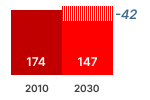 | STOCK (x1000 units) 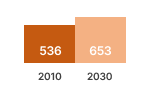 | Electricity (TWh/a) 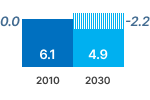 |
GHG-EMISSION 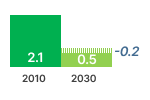 | CONSUMER EXPENSES 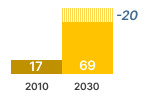 | REVENUES 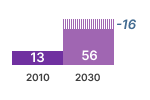 |
Source: estimations from the Ecodesign Impact Accounting Overview Report 2024
In 2020, 687 million phones and tablets were in use in the EU27, an average of 1.5 device per person. Of these, 55% were smartphones, 19% tablets, 16% cordless (landline) phones, and 10% other mobile phones.
Cordless phones, on average, were in active use for 9.6 minutes per day, charging for 4.5 minutes per day, and in various standby modes for the rest of the time. The latter leads to 855 billion hours networked standby per year in the EU27 in 2020.
The power adapters for smart phones and tablets were actively charging for 2.5 hours per day, ‘trickle charging’ (maintaining battery charge at a high level) for 9.5 hours per day, and in no-load mode (phone not attached) for 12 hours per day.
In 1990, the annual electricity consumption for (networked) standby of the base stations and charging cradles of cordless landline phones was 37.1 kWh. In 2020, without measures, this would have been 24.5 kWh. Due to the Ecodesign standby regulation, this was reduced to 16.1 kWh in 2020, a 34% saving. Due to the addition of the 2023 Ecodesign regulation on phones, this is expected to further reduce to 8.0 kWh in 2030, a 63% saving versus no measures.
The 2023 Energy Labelling regulation promotes the use of energy efficient devices with longer operating time per unit of battery capacity. This leads to a decrease in battery charging time (from 2.5 to 1.75 hours per day), and a corresponding increase of the trickle charge time (from 9.5 to 10.25 hours per day). As the trickle charge power (0.5W) is much smaller than the battery charging power (3-11W), this time-shift leads to energy savings.
For high-end smartphones the reduction in annual electricity consumption in 2030 is from 12.2 to 9.2 kWh (-25%), and for tablets from 8.8 to 6.8 kWh (-23%).
The Ecodesign and Energy Labelling regulations are projected to save 2.2 TWh of electricity in 2030, a 31% saving compared to a scenario without measures.
These savings are 0.09% of the total EU27 electricity consumption in 2020.
The 2023 regulations promote repairability, aiming at lifetime extension. Without changes to the number of products in use, the lifetime extension implies a decrease in annual sales. This means lower environmental impacts during production, but also lower acquisition costs for users, due to less frequently buying a new device.
In 2030, the savings on EU27 acquisition costs are € 20 billion, which combined with € 0.6 bn lower energy costs and € 0.8 bn additional repair costs, leads to € 19.8 billion (22%) expense savings (€ 98 per household).
Expected Savings
The 2023 regulations do not set energy efficiency requirements, but the Energy Labelling scheme promotes the use of smartphones and tablets that can operate longer on a full-charged battery, per unit of battery capacity. This means a less frequent need for recharging. In 2030, this saves 1.1 TWh (21%) of electricity compared to a scenario without measures. Another 1.1 TWh of electricity saving derives from maximum power requirements on (networked) standby for the base stations and charging cradles of cordless phones (in the EIA these are the combined effects of standby regulations 1275/2008 and 2023/826, and phones and tablets regulation 2023/1670). These 2030 electricity savings correspond to 4.2 TWh (15 PJ) primary energy savings in the use-phase (PEF=1.9).
Due to the drop in sales following the lifetime extension measures, an additional primary energy saving of 3.9 TWh (14 PJ) is obtained in the production phase (grey in graph below). Hence, the overall primary energy savings in 2030 are 8.1 TWh (29 PJ), but those for the production phase will be mainly outside the EU27.
The user expense savings in 2030 are €20 billion (-24% compared to BAU 2030) and derive almost entirely from the lower acquisition costs due to the drop in sales. The energy cost savings of €0.6 bn and the additional repair and maintenance costs of €0.8 bn are small in comparison.
Source: estimations from the Ecodesign Impact Accounting Overview Report 2024

Suppliers
Suppliers shall ensure that:
(a) each smartphone or slate tablet is supplied with a printed label in the format as set out in Annex III;
(b) the values of the parameters of the product information sheet, as set out in Annex V, are entered into the public part of the product database;
(c) where specifically requested by the dealer, the product information sheet is made available in printed form;
(d) the content of the technical documentation, as set out in Annex VI, is entered into the product database;
(e) any visual advertisement for a specific model of smartphones or slate tablets contains the energy efficiency class and the range of energy efficiency classes available on the label in accordance with Annexes VII and VIII;
(f) any technical promotional material concerning a specific model of smartphones or slate tablets, including technical promotional material on the internet, which describes its specific technical parameters includes the energy efficiency class of that model and the range of energy efficiency classes available on the label, in accordance with Annex VII;
(g) an electronic label in the format and containing the information, as set out in Annex III, is made available to dealers for each smartphone and slate tablet model;
(h) an electronic product information sheet, as set out in Annex V, is made available to dealers for each smartphone and slate tablet model.
The energy efficiency class and the repeated free fall reliability class as set out in Annex II shall be calculated in accordance with Annex IV.

Dealers
Dealers shall ensure that:
(a) each smartphone and slate tablet, at the point of sale, including at trade fairs, bears the label provided by suppliers in accordance with point (a) of Article 3(1) displayed in proximity to the product or hung on it or placed in such a way as to be clearly visible and unequivocally associated to the specific model;
(b) in the event of distance selling, the label and product information sheet are provided in accordance with Annexes VII and VIII;
(c) any visual advertisement for a specific model of smartphones or slate tablets, including on the internet, contains the energy efficiency class and the range of energy efficiency classes available on the label, in accordance with Annex VII;
(d) any technical promotional material concerning a specific model of smartphone or slate tablet, including technical promotional material on the internet, which describes its specific technical parameters includes the energy efficiency class of that model and the range of energy efficiency classes available on the label, in accordance with Annex VII.

Policy
Regulation (EU) 2023/1670 of 16 June 2023 laying down Ecodesign requirements for smartphones, mobile phones other than smartphones, cordless phones and slate tablets pursuant to Directive 2009/125/EC of the European Parliament and of the Council and amending Commission Regulation (EU) 2023/826 (Text with EEA relevance).
Delegated Regulation (EU) 2023/1669 of 16 June 2023 supplementing Regulation (EU) 2017/1369 of the European Parliament and of the Council with regard to the Energy Labelling of smartphones and slate tablets (Text with EEA relevance).
What is the aim of the regulations?
The regulations aim to limit the environmental impact of mobile and cordless phones and tablets being placed on the European Union (EU) market by introducing minimum requirements.
Key points
- As part of the European Green Deal, the European Commission has adopted two regulations for smartphones and tablets, this one on Ecodesign* and another on energy labelling. Together, they aim to allow EU consumers to make more informed and sustainable purchasing choices and encourage sustainable consumption.
- The Ecodesign regulation is an implementing measure of Directive 2009/125/EC (see summary). It amends Commission Regulation (EU) 2023/826 (see summary).
Main features
- The Ecodesign requirements are set out in Annex II, these include rules on:
- resistance to accidental drops or scratches, protection from dust and water;
- durability of batteries – batteries should withstand at least 800 cycles of charge and discharge while retaining at least 80% of their initial capacity;
- disassembly and repair – including obligations for producers to make critical spare parts available to repairers within 5-10 working days, and until 7 years after the end of sales of the product model on the EU market;
- operating system upgrades – for at least 5 years from the date of the end of placement on the market of the last unit of a product model
- non-discriminatory access for professional repairers to any software or firmware needed for the replacement.
- The regulation specifies which conformity assessment procedures apply.
- EU Member States’ national authorities must apply the verification procedures laid down in Annex IV when carrying out market surveillance checks.
- The regulation specifically forbids devices designed to alter their performance under testing.
- Annex V sets out indicative benchmarks for the best-performing products and technology available on the market.
Review
- The Commission must review this regulation in the light of technological progress by September 2027.
From when does the regulation apply?
It applies from 20 June 2025.
Background
For further information, see:
- The new Ecodesign measures explained (European Commission)
- About the energy label and Ecodesign – Energy savings (European Commission).
Disclaimer: please pay attention to possible updates/changes as indicated in the Official Journal (green dot)
